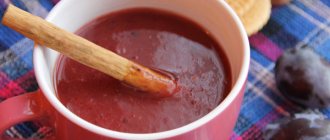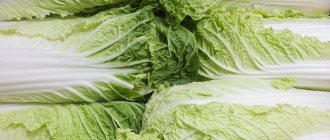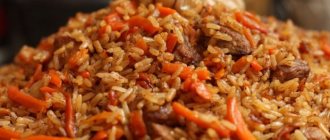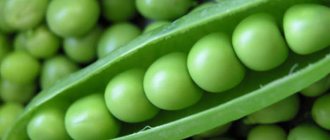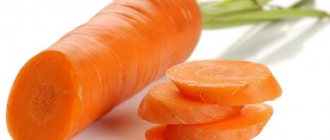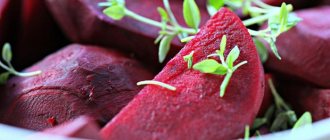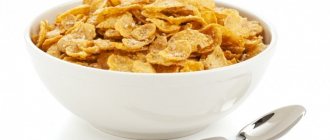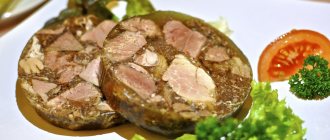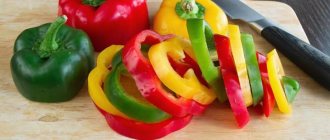A woman’s diet after childbirth and during breastfeeding should be complete and balanced. The health and development of the baby, whose food is breast milk, directly depends on this. WHO experts concluded that strict adherence to the diet by a mother who is feeding her baby with breast milk is inappropriate. The exception is cases of severe allergic reaction in a child to certain types of products. A nursing mother's diet must include fresh vegetables and fruits, dairy products, meat and fish. Dishes containing several ingredients should be included in the menu with caution, monitoring the child’s reaction. If he feels well, then mom can expand the diet by adding more complex dishes, such as borscht or vegetable stew. In the case when the baby suffers from painful colic and problems with digestion of food, then you need to decide whether borscht is possible during breastfeeding after consulting with your pediatrician.
When to introduce borscht into the diet of a nursing mother
Borscht is a nourishing, easily digestible and tasty dish. It is useful to include in the diet for several reasons.
- Contains a balanced combination of essential nutrients.
- Boiled meat is easily digested and satiating.
- Vegetables are the main source of vitamins.
It is necessary to decide whether borscht is suitable for nursing mothers strictly individually, having first consulted with a doctor. This is a complex dish and must be introduced into the diet with extreme caution. In the first weeks of your baby's life, be extremely attentive to your diet when breastfeeding. The digestive system is vulnerable during this period. It is better to adhere to some dietary restrictions. It is advisable to exclude fatty, fried, hot and spicy foods, smoked foods, and carbonated drinks. There are no exact dates when a nursing mother can eat borscht. If the child is not allergic to red and orange vegetables, then you can start introducing everyone’s favorite first course into the diet of a nursing mother from the fourth month of the child’s life. This should be done gradually, starting with small portions in the first half of the day. Sometimes a woman has to give up her favorite dish. Borscht can cause flatulence in a baby and cause indigestion. The dish contains many components, such as beets, carrots, tomatoes, which can cause allergies, colic and pain in the baby. If negative consequences do appear, then mom should wait to introduce borscht into her menu. Next time you should include it in your diet no earlier than 2 months later.
When can you start eating borscht?
For the first 2-3 months after giving birth, it is better to follow a diet. The child’s body is still weak and adapts to environmental conditions. After this, you can begin to introduce new products. This must be done gradually and little by little. It's also good to keep a food diary.
The first time you eat borscht, you can eat only 1-2 spoons. It is better to do this in the morning to closely monitor the baby. What should you be wary of? These are rashes on the body, colic, increased gas formation, and child anxiety. It is possible that his body is not yet ready to accept this food with mother's milk. A child may react to vegetables such as beets, tomatoes, carrots, primarily due to their color. Cabbage in large quantities can cause intestinal upset and colic (see Cabbage for breastfeeding).
If the described symptoms are absent, a nursing mother can eat borscht in a slightly larger volume next time. But, again, watch the child. This is how all new foods are introduced into the diet.
Cooking the right borscht
Traditionally, this first course includes the following ingredients: beef or pork, beets, carrots, potatoes, tomato juice or tomato paste, onions, herbs. During breastfeeding, a woman should eat only freshly prepared borscht in veal, chicken or rabbit broth. Before cooking, it is recommended to soak the meat in water for several hours. To preserve the maximum amount of vitamins and minerals, it is better not to fry vegetables, but to add them fresh to the boiling broth. Carrots and beets can be pre-boiled, in which case they will not lead to allergies in the child. To prevent painful colic in the baby, when preparing borscht for a nursing mother, it is recommended to exclude the use of white cabbage. It is better to add cabbage in the form of inflorescences, boiling it until fully cooked. It is advisable not to use tomato paste, as well as tomato juice, but replace them with fresh yellow tomatoes, after peeling the tomatoes. When preparing borscht, a nursing mother should avoid using a large amount of spices and garlic. For spices, you can add bay leaf and allspice, dill or parsley. If desired, it is permissible to add a little low-fat sour cream to the finished dish. If only fresh ingredients were used when preparing borscht, then you don’t have to worry about the nursing mother and baby.
Is it possible for a nursing mother to have borscht?
Sometimes nursing mothers are too strict about their diet, depriving themselves of tasty and healthy dishes, for fear of harming the baby. Borscht is often included in the list of exceptions due to the content of allergenic foods (beets, carrots, tomatoes, pork). But should we be afraid? Is it possible to eat borscht while breastfeeding? How to properly prepare a dish so that mommy can eat it without fear for the baby’s health?
Experts' opinion
Achieving the most “clean” diet in terms of allergens, women often go to the extreme, leaving only zucchini, buckwheat and kefir on the menu. Yes, the baby will definitely not have rashes from such food, but the mother will not last long either. To restore the body of a woman who has given birth, she needs vitamins and nutrients, which can only be provided by rational, nutritious nutrition.
Can a nursing mother eat borscht? In terms of proper nutrition, borscht is an excellent healthy dish. Meat gives the soup satiety and enriches the body with protein, vegetables are perfectly digestible and ensure good digestion.
Experts in no way prohibit the consumption of borscht while breastfeeding. But there is one caveat: the soup must be prepared correctly. The traditional recipe for delicious, rich borscht will have to be slightly adjusted so that a nursing mother can eat it without fear.
Rules for preparing borscht for a nursing mother:
- You need to choose lean meat for the broth (veal, chicken, turkey).
- Use only fresh vegetables. There should be no canned ingredients!
- The soup must be prepared without traditional “frying”, that is, the vegetables can first be stewed with a drop of oil, but under no circumstances should they be fried.
- Do not add hot seasonings or garlic to the dish.
- You will also have to give up tomato paste; it is better to use fresh tomatoes.
- Sour cream with a fat content of no more than 10% is suitable for dressing.
- Housewives often add vinegar to borscht to make the soup a rich red color. Breastfeeding makes adjustments here too: instead of vinegar, it is better to use lemon juice or a little citric acid.
Most mothers are concerned about the question of whether it is possible to cook borscht with cabbage. After all, there is an opinion that this vegetable on the mother’s menu causes gas formation, constipation and colic in the baby. You can add cabbage to soup, but only fresh cabbage (sauerkraut is much more dangerous in terms of colic and gas). The amount of vegetable should not be too large. If the baby reacts sharply to white cabbage in the mother’s diet, then it can be replaced with fresh beet tops, broccoli, cauliflower or sorrel.
Experts advise including borscht in a nursing mother’s diet no earlier than 4-6 months of the child’s life. This dish is also not recommended as complementary feeding for children under one year of age.
According to breastfeeding consultants and pediatricians, borscht prepared according to these recommendations will not harm the baby if the mother is careful and wisely approaches the amount of soup eaten.
Of course, in the first month of the baby’s life it is better to avoid this dish. In the future, if the child does not have a tendency to allergies and feels well, you can add new dishes and products to the diet, including borscht.
There are exceptions to any rules. If mother and baby are healthy and feel well, then you can try introducing red soup into the diet at 2-3 months of the baby’s life. If you are careful, in most cases the appearance of a new dish on your mother’s menu occurs without consequences or complications.
Rules for introducing borscht into the diet of a nursing woman:
We recommend reading: Cauliflower for a nursing mother
- You can try borscht for the first time only if the baby is completely healthy, he is not teething and vaccinations are not expected in the near future.
- The daily serving of soup should not exceed 250 g.
- It is better to eat soup before lunch, so that you have the opportunity to observe the child’s possible negative reaction before nightfall.
- You need to monitor the baby over the next day.
- If the baby does not have a negative reaction, then borscht can be eaten at any time of the day, not just in the morning.
- If a rash or colic appears in the baby, the nursing mother must strictly exclude borscht from the diet for several months.
- If mommy ate borscht for the first time, then no other new product can be eaten that day.
Recipes for proper borscht for a nursing mother
Green borscht
Ingredients:
- Lean meat – 500 g.
- Potatoes – 2-3 pcs.
- Carrots – 1 pc.
- Onions – 1 pc.
- Green sorrel – 2 small bunches.
- Parsnip – 1 pc.
Perhaps the mother or child is already allergic to beets.
In this case, a green borscht recipe will help out. This soup will be completely safe, it can be included in the menu from the first month of breastfeeding . Preparation:
- Place the meat in cold water and cook the broth for 1.5 hours, skimming off the foam.
- Place chopped potatoes into the boiling broth.
- Finely chop the onion and grate the carrots on a medium grater. Add vegetables to potatoes. Do not fry!
- Add chopped parsnips to the broth.
- At the end of cooking, when the vegetables have become soft, add chopped sorrel and leave the soup on the fire for another couple of minutes.
- Before serving, you can add fresh herbs and half a boiled egg to the dish if the child does not have allergies.
"Classic" borscht
The recipe can only be called a classic one. When preparing soup, certain changes are made to the standard recipe to make it suitable for a nursing woman.
- Lean meat (chicken, veal) – 500 g.
- Potatoes – 3 pcs.
- Onions – 1 pc.
Ingredients:
- Carrots – 1 pc.
- Beets – 1 pc.
- Lemon juice – 4 teaspoons.
- Fresh white cabbage – 200 g.
Preparation:
- The meat broth is cooked over low heat for at least 1.5 hours. The foam needs to be removed.
- Potatoes are cut into cubes and placed in boiling broth.
- Cabbage is cut into strips and added to the potatoes.
- Carrots and beets are grated on a medium grater, onions are cut finely. Vegetables need to be stewed in a frying pan with a spoonful of sunflower oil. While stewing, you can add broth from the pan.
- When the vegetables in the pan become soft, add lemon juice.
- Ready stewed vegetables are placed in a saucepan. The soup is cooked for another 2-3 minutes. You can put a couple of bay leaves.
- Salt is added to the finished soup to taste. You can add herbs or other seasonings of your choice, as long as they are not spicy.
Cold borscht (Kholodnik)
Since the recipe includes eggs, the dish is not suitable for mothers of babies with allergies. It is better to introduce such soup into the diet no earlier than 5-6 months of the baby’s life.
Ingredients:
- Beets – 2 pcs.
- Fresh cucumber – 2 pcs.
- Hard-boiled chicken egg – 2 pcs.
- Green onions – 1 small bunch.
- Lemon juice – 1 tablespoon.
- Water – 1 liter.
- Salt - to taste.
- Sugar – 1 tablespoon.
Cold borscht is a wonderful summer version of your favorite dish
. Preparation:
- Wash the beets, peel them, cut into thin strips.
- Place the beets in a saucepan, add sugar and lemon juice, add boiling water and cook for half an hour. Cool.
- Cut the eggs into cubes.
- Wash the cucumbers, if the skin is thick, peel and cut into cubes.
- Finely chop the green onions.
- Pour all the chopped ingredients into the pan with the boiled beets.
- Add salt to taste.
- Serve the finished soup with sour cream and herbs.
Borscht is a tasty and satisfying dish. And a nursing mother, of course, should not deny herself it. The main thing is to observe moderation and approach the preparation of the dish correctly.
mladeni.ru
Recipes
There are many recipes and methods for preparing this tasty and healthy first course:
- Lenten borscht is prepared in vegetable broth. This dish is suitable for nursing vegetarian mothers or when the child is allergic to meat.
- Green borscht contains the maximum amount of vitamins and microelements that are beneficial for women and babies.
- A dish with beans will be more nutritious. In terms of easily digestible protein content, legumes are slightly inferior to meat, and they contain even more B vitamins.
When a nursing mother consumes borscht, it is necessary to monitor the baby’s condition. If a woman’s diet does not cause negative consequences, then the diet can be expanded, gradually returning to the usual menu.

